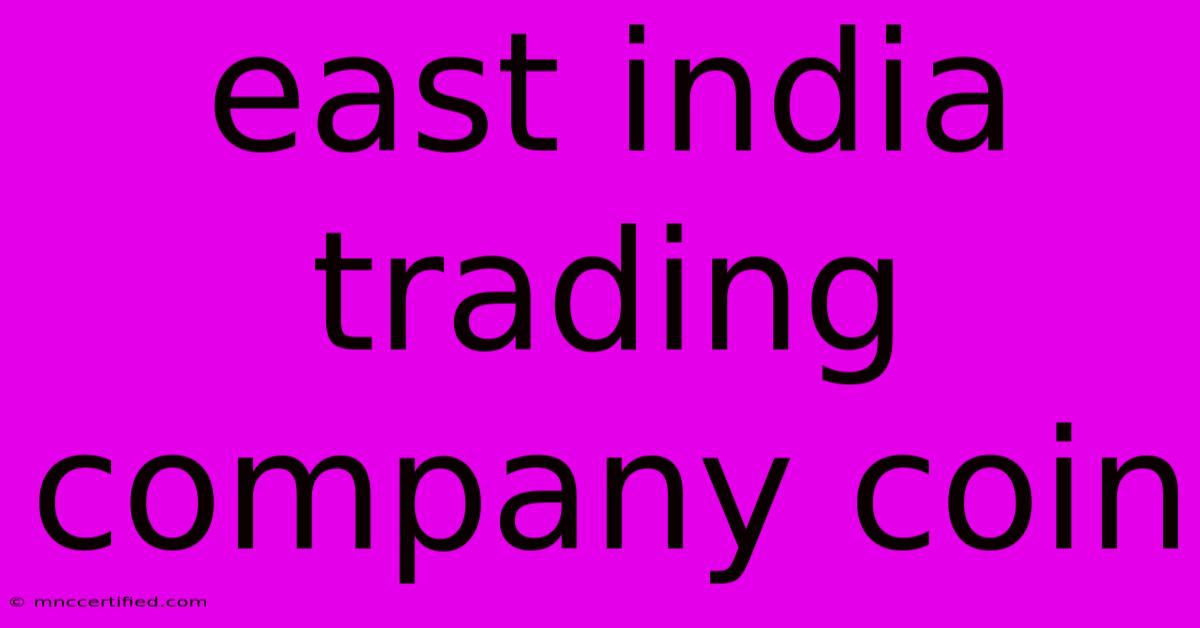East India Trading Company Coin

Table of Contents
East India Company Coins: A Collector's Guide to Numismatic History
The East India Company, a powerful force in global trade for centuries, left behind a fascinating legacy – its coinage. These coins, minted across various presidencies and periods, offer a captivating glimpse into a pivotal era of economic and political history. This comprehensive guide explores the world of East India Company coins, covering their history, identifying features, and value to collectors.
A Brief History of the East India Company's Coinage
The British East India Company, established in 1600, didn't initially mint its own coins. Early trade relied on existing currencies in the regions they operated. However, as their influence grew, the need for a standardized and reliable currency became apparent. This led to the establishment of mints in various presidencies – Bengal, Madras (Chennai), and Bombay (Mumbai) – each producing coins with unique characteristics.
The types of coins varied greatly depending on the region and period. Early coins often mimicked local designs and denominations, gradually evolving to incorporate British stylistic elements. Common metals included silver and copper, with gold coins being less prevalent. The designs often featured the company's emblem, the East India Company crest, along with the reigning monarch's image or initials, and the year of minting or reign.
Key Periods in East India Company Coinage:
- Early Period (17th-18th Centuries): Characterized by a diversity of designs reflecting local influences and experimentation with different metals and denominations. These are often highly sought after by collectors due to their rarity and historical significance.
- Mid-Period (Late 18th-Early 19th Centuries): Shows a move towards standardization, with a clearer adoption of British design elements and a more consistent use of the company's crest. These coins are generally more readily available than earlier examples.
- Late Period (Mid-19th Century Onwards): As the company's power waned and India transitioned under direct British rule, the distinctive East India Company coins began to be replaced by coinage issued by the British Crown. These later coins can still hold significant value, particularly those from the final years of the company's existence.
Identifying Key Features of East India Company Coins
Authenticating East India Company coins requires careful examination. Key features to consider include:
- Metal: Determine the metal composition – silver, copper, or gold – as this significantly impacts value.
- Weight and Diameter: Compare the coin's dimensions to established standards for the particular type and denomination. Variations can indicate counterfeits.
- Design Elements: Closely scrutinize the imagery – the company's crest, the monarch's effigy (if present), and any inscriptions. Look for inconsistencies or unusual characteristics that might suggest a forgery.
- Mint Mark: Identifying the mint mark (e.g., a specific letter or symbol) helps pinpoint the origin and date of the coin.
- Condition: The condition of the coin greatly influences its value. Grading systems (such as the Sheldon Scale) are used to assess factors like wear, scratches, and overall preservation.
Common Denominations:
While denominations varied across presidencies and time periods, some common types include rupees, annas, and pice. Understanding the different denominations is essential for accurate identification and valuation.
The Value of East India Company Coins to Collectors
East India Company coins are highly sought after by numismatists worldwide. Their historical importance, unique designs, and relative rarity contribute to their value. The price varies greatly depending on factors like:
- Rarity: Extremely rare coins can command substantial prices.
- Condition: Well-preserved coins are worth significantly more than damaged ones.
- Demand: Popular coin types or those in high demand tend to have higher values.
- Provenance: A clear and documented history of ownership can positively impact value.
Where to Find and Learn More About East India Company Coins
Several resources can aid in your exploration of East India Company coins:
- Online Auction Sites: Sites like eBay and specialized auction houses offer a wide selection of coins, but be sure to buy from reputable sellers.
- Numismatic Societies and Clubs: Joining a coin collecting club connects you with experienced collectors and experts who can provide guidance.
- Reference Books and Catalogs: Dedicated numismatic publications offer detailed information on identifying and valuing East India Company coins.
- Museums and Historical Societies: Museums often exhibit historical coins, providing a valuable learning experience.
Disclaimer: This article is for informational purposes only. Always consult with experienced numismatists for accurate identification and valuation before purchasing or selling East India Company coins. Be wary of counterfeit coins, and ensure you're buying from reputable sources.
By understanding the historical context, identifying key features, and researching market values, you can embark on a rewarding journey into the fascinating world of East India Company coins. Happy collecting!

Thank you for visiting our website wich cover about East India Trading Company Coin. We hope the information provided has been useful to you. Feel free to contact us if you have any questions or need further assistance. See you next time and dont miss to bookmark.
Featured Posts
-
Maui Woman Missing Father Found Dead
Nov 26, 2024
-
Is A Townhome A Good Investment
Nov 26, 2024
-
Ronaldos Impact Al Nassr Eyes Asian Cl
Nov 26, 2024
-
Court Hearing Menendez Brothers Together
Nov 26, 2024
-
Trading In The Zone Doctype Pdf
Nov 26, 2024